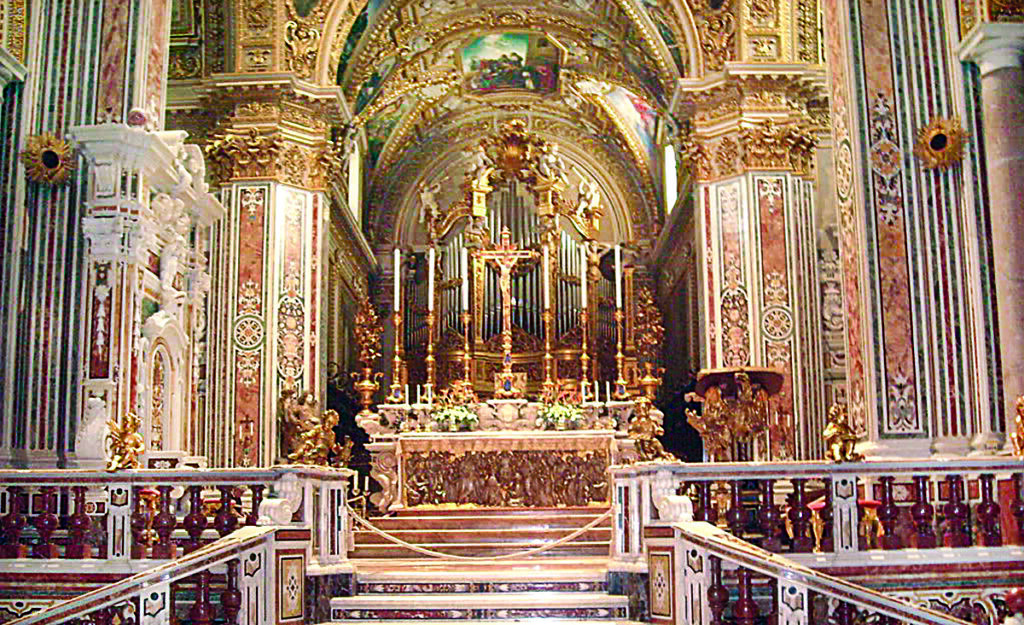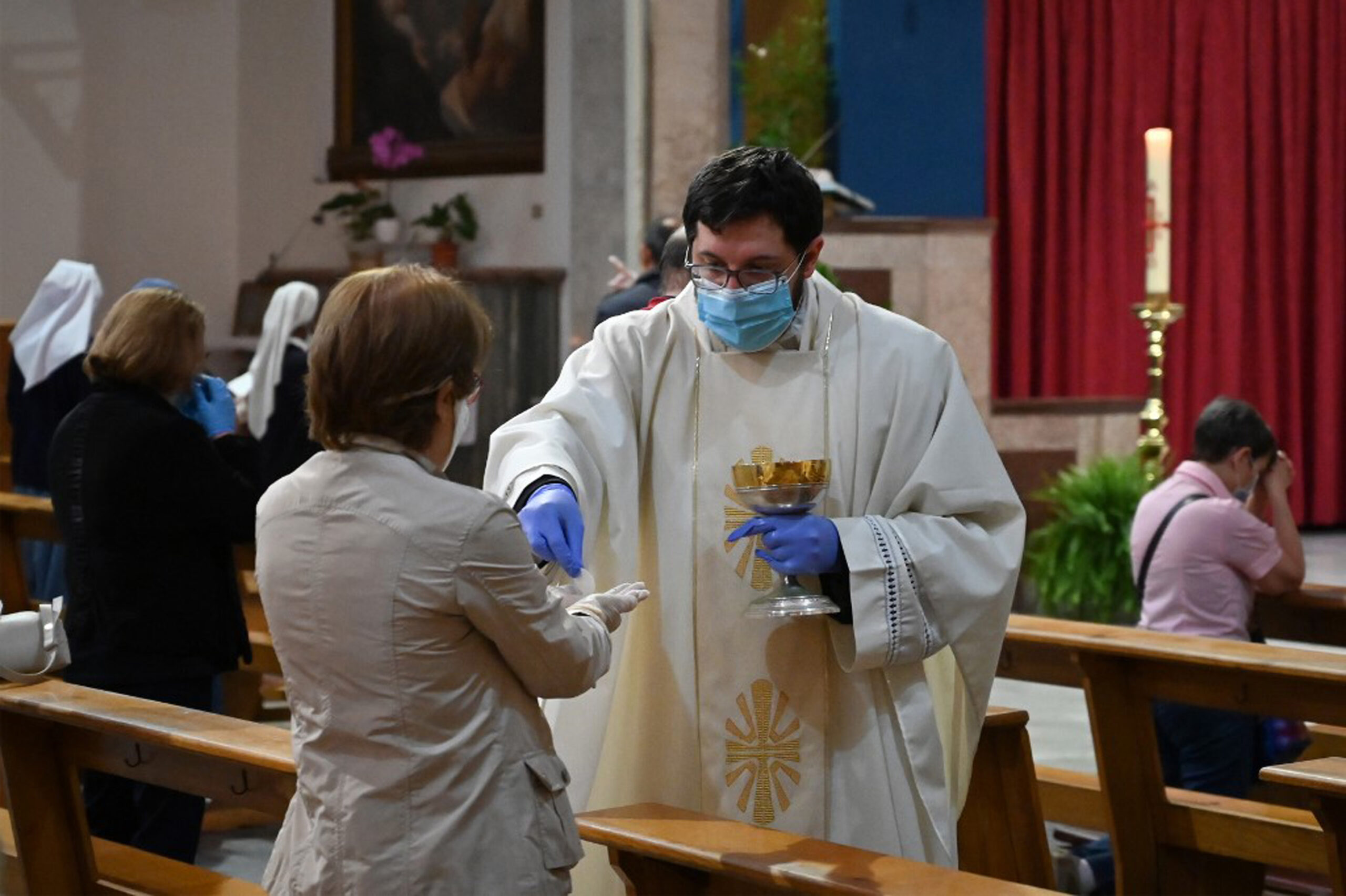Monte Cassino is a small town about 80 miles south of Rome. It is the home of the sacred relics and the monastery of St. Benedict (480-543), the patron saint of Europe and the founder of western monasticism. Since its founding by St. Benedict in 529 AD, Monte Cassino Monastery has had a troubled history, suffering from repeated attacks, pillage and natural disasters. It was the site of a terrible battle during World War II that resulted in great loss of life and complete destruction of the monastic buildings.
During the war, the Allies landed in southern Italy in September, 1943. The armies advanced northward along two fronts, one on each side of the Apennine Mountains. The U.S. Fifth Army moved from the main base in Naples up the western side; while in the east, General Sir Bernard Montgomery’s British Eighth Army advanced up the Adriatic coast.
The Fifth Army made slow progress in the face of difficult terrain, wet weather and skillful German defenses. The Germans were fighting from a series of prepared positions in a manner designed to inflict maximum damage. When they could no longer hold their ground, they pulled back, but continued to buy time for the construction of the so-called Winter Line – the defensive positions south of Rome. The original estimates by the Allies that Rome would fall by October, 1943 proved to be far too optimistic.
In the early weeks of 1944, the Allied troops were advancing north, mile by mile. The Battle of Monte Cassino was a series of four assaults by the Allies against the defensive territory held by Axis forces during the Italian Campaign of World War II. The intention of the Allies was to break through the Winter Line and march onto Rome. At the beginning of 1944, the western half of the Axis defenses were anchored by Germans holding the Rapido-Gari, Liri and Garigliano valleys, as well as some of the surrounding peaks and ridges. Together, these features formed the Gustav Line. Monte Cassino, the historic hilltop abbey, dominated the nearby town of Cassino and the entrances to the Liri and Rapido valleys. Lying in a protected historic zone, it had been left unoccupied by the Germans. They had manned some positions set into the steep slopes below the abbey’s walls.
With repeatedly accurate artillery attacks by the Germans on Allied assault troops, U.S. generals concluded that the abbey was being used by the Germans as an observation post. Fears of this escalated along with many casualties. The abbey was then marked for destruction. The bombing mission on the morning of February 15, 1944, involved 229 bombers. The air armada dropped 1,150 tons of high explosives and incendiary bombs on the abbey, reducing the entire top of Monte Cassino to a smoking mass of rubble. Between bomb runs, the II Corps artillery pounded the mountain, but the raid failed to achieve its objective. German paratroopers occupied the rubble and established excellent defensive positions amid the ruins. Pope Pius XII was silent after the bombing; however, his Secretary of State, Cardinal Luigi Maglione, bluntly stated to the senior U.S. diplomat to the Vatican, Harold Tittmann, that the bombing was “a colossal blunder . . . a piece of a gross stupidity.”
Between January and May, the assaults on Monte Cassino and the Gustav defenses culminated with a drive of twenty Allied divisions attacking along a twenty-mile front. The German defenders were finally driven from their positions, but at a high cost. The capture of Monte Cassino resulted in 55,000 Allied casualties, with German losses being far fewer, estimated at roughly 20,000 killed and wounded.
Despite its significant and frequent setbacks, the monastery has always been rebuilt and the relics of Saints Benedict and Scholastica have survived through all the turmoil. The building that stands today was constructed after 1944, using the old plans.
Today, Monte Cassino is a working monastery and continues to be a pilgrimage site for the faithful to see the surviving relics of St. Benedict and his sister, St. Scholastica. It is also a popular tourist destination due to its historical importance. Monte Cassino Abbey still sits atop a large hill, below which lies the city of Cassino. A vast war cemetery covers a hillside across the valley, which can be easily seen from the abbey. The Basilica, richly decorated in stucco and mosaics, enshrines the relics of St. Benedict and St. Scholastica. The abbey museum displays medieval art and artifacts from the monastery and explains the history of monasticism, while the monastic church (the main destination for pilgrims) features an urn under the high altar containing the relics of the two saints.
Other sights to see in Cassino include the Palagio Badiale, located in Piazza Badiale Court. It was entirely rebuilt after the war by architect Giuseppe Breccia Fratadocchi, who also oversaw the reconstruction of the abbey and the Church of St. Scholastica. Construction was completed in 1951. Today it houses the Monte Cassino curia. The Baron De Rosa Palace, located in Di Blasio, next to Via Monte Cassino, is the only building that remained standing after the bombing which destroyed the city. Its construction dates from the early nineteenth century and it belonged to the family of Baron De Rosa, a Neapolitan entrepreneur. Due to its strategic position and access to the Cassino train station, the town and the road to both Rome and Sora was occupied during World War II by a platoon of German paratroopers.
Italy Reopens!
At the foot of Monte Cassino is the archaeological park of Casinum. The area includes the remains of the ancient Roman city of the same name. It is divided into a series of terraces, crossed by roads parallel to each other. The archaeological park includes a path where visitors can observe the megalithic walls, substructures, amphitheater and the mausoleum Ummidia Quadratilla.
Other museums in the area also have a military emphasis, as would be expected. The Museum Historiale War in Cassino tells the history of the battle with exhibits including war memorabilia. The Cassino War Cemetery is a military cemetery located near the Folcara University campus. The fallen soldiers of the Commonwealth countries involved in the Battle of Monte Cassino are buried there, with 4,266 graves containing the remains of soldiers from eight different Allied nations.
The beautiful setting of the area today is exemplified by the Villa Comunale (renamed Park XV in March of 1944 for the date of Cassino’s destruction), the largest park in the city. It has expansive open areas and is crossed by two branches of the Gari river which come together to create a picturesque lake. The park, as does the entire area, stands in stark contrast to the devastation that war had brought to Monte Cassino seventy-two years ago. Although now popular with tourists, residents and visitors alike will always remember the link that Monte Cassino has with its not too distant past.






